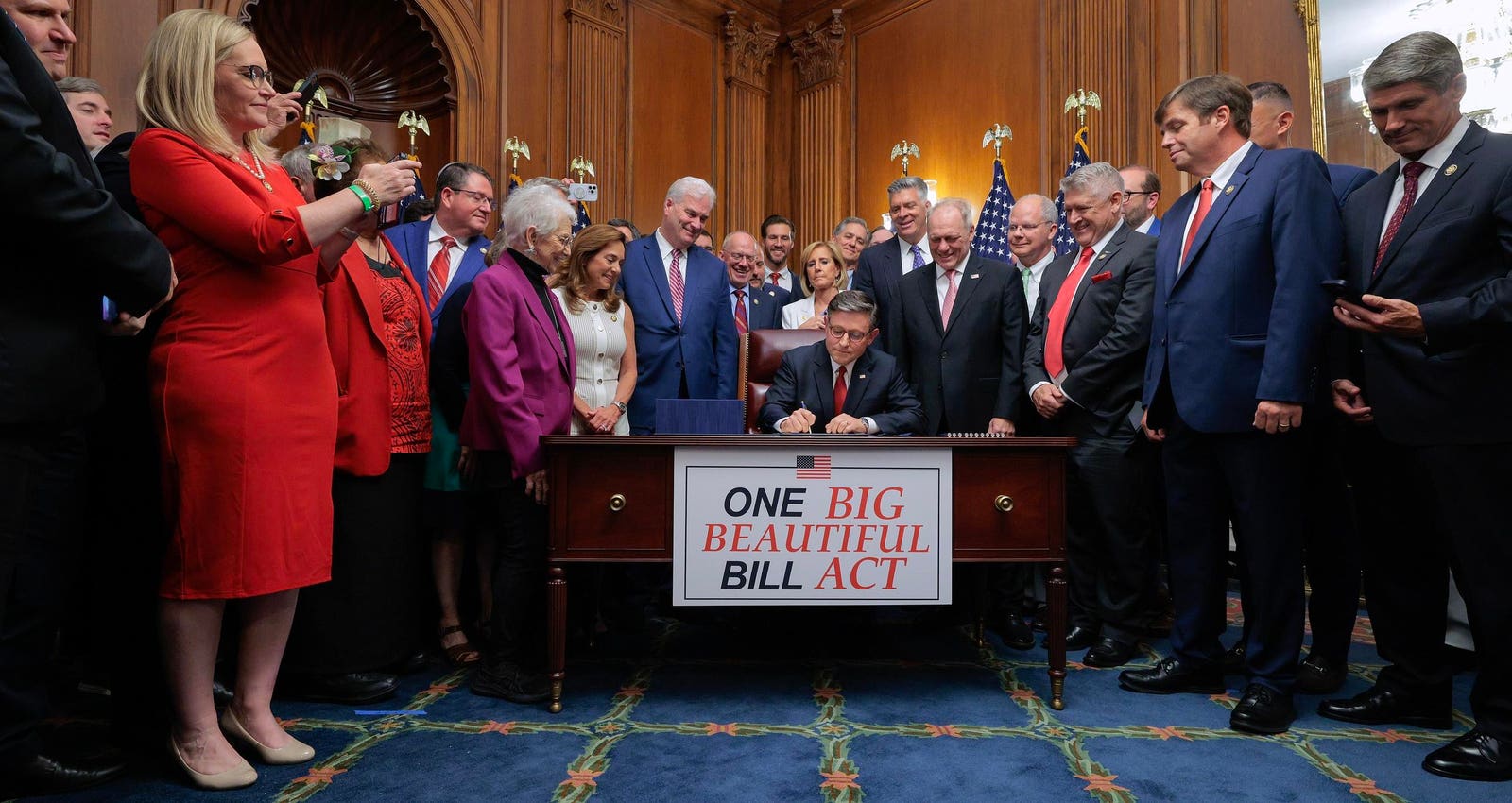WASHINGTON, DC – JULY 03: U.S. Speaker of the House Mike Johnson (R-LA) shakes hands with Rep. Jodey … More
Since the pandemic struck the U.S., most Americans have developed a keen appreciation of their hospitals and an equal awareness of how fragile these hospital systems really are. Which is why it’s critical to understand the role that Medicaid and Medicaid State-directed payments (SDPs) play in the survival of what are known as Safety Net Hospitals. And what’s even more important is how the passage of the One Big, Beautiful Bill Act will now affect Medicaid and those SDPs, supporting these hospitals.
So what are Safety Net Hospitals and what do they do? As the name implies, these hospitals play a critical role in the U.S. Healthcare system, they are literally the lifeline for vulnerable populations, including those who are uninsured or have Medicaid. They serve as a “safety net” by offering services regardless of a patient’s ability to pay or their insurance status. These hospitals are often located in low-income communities and rural areas.
These hospitals also often operate on fragile margins (approximately 39% experience negative margins), and their reserve funds, an indicator of stability, are not comforting. Without adequate reserve funding, a hospital or nursing home is unable to function in the event of a downturn in reimbursements. Inadequate cash reserves, measured in the number of days the facility can continue operating with no or delayed income, portend the collapse or even closure of the operation.
What is the financial lifeblood for these hospitals are the aforementioned SDPs, this payment arrangement permit states under 42 CFR 438.6(c) to make supplemental payments to hospitals for Medicaid patients which can amount to even more than Medicare payment coverage. This funding is critical in covering hospital operations and when you consider that the days of cash on hand in 1 in 10 hospitals is less than 110 days, they are literally rated “Vulnerable” or worse, “Highly Vulnerable.”
The Rural Health Transformation Program
The Act does acknowledge the fragility of rural hospitals and has an initiative called The Rural Health Transformation Program which will appropriate $10 billion per fiscal year to Centers for Medicare & Medicaid Services (CMS) for fiscal years 2026-2030, for a total of $50 billion over five years to help them. But this deficit math simply doesn’t add up and even the details of their administration are vague. Adding to the problem, the The Act makes it more difficult for states to close payment shortfalls by restricting their ability to use provider taxes to boost Medicaid payments. This further limits resources for hospitals and increases financial pressure, especially in states that have used these mechanisms to support rural and Safety Net Hospitals.
According to Becker’s Hospital Review, for the first time in the last decade, the average number of days cash on hand dropped below 200 to 196.8. The upper half of U.S.-based nonprofit acute healthcare providers reported an average of 292 days, while the lower half reported an average of 128 days.
Healthcare profession teamwork and doctor service concept – International medical staff group of … More
Health Workforce Layoffs And Hospital Closures
This is more than a hypothetical forecast. A recent report documents 18 hospital and emergency department closures or forced mergers so far this year. Another study found that several hospitals and health systems are reducing their workforces or jobs amid financial and operational challenges. To cite one example, Columbus (Ind.) Regional Health (CRH) notified the state that it will lay off 50 employees. The layoffs come as the health system plans to close its inpatient rehabilitation unit and the CRH Orthopedics and Sports Medicine outpatient practice, according to a news release dated June 30.
Unsurprisingly, the closures negatively affect local healthcare access with broader consequences for the community and its economy. Layoffs and closures, especially in rural or smaller communities, often result in fewer available services, longer waiting times, and, in some cases, the complete loss of essential departments, such as emergency rooms or maternity wards.
As a result of these cutbacks, medical care is compromised and everyone suffers. . With fewer staff members, remaining employees face increased workloads and higher stress, which can lead to burnout and a decline in morale. This often translates to longer wait times, rushed patient interactions, and increased risk of medical errors. Under such circumstances, healthcare workers often experience burnout, job insecurity, and increased turnover, all of which exacerbates staffing shortages and negatively impacts patient care. Many hospitals, especially those with negative. Many hospitals, especially those with already negative or low operating margins, may be forced to reduce services, lay off staff, or close altogether. This risk is especially acute for rural hospitals, which often operate on thin margins and heavy reliance on Medicaid funding.
Healthcare facility closures, especially in rural areas, have a ripple effect on the communities they once served because hospitals are often among the largest local employers. Workforce reductions decrease household incomes, reduce local consumer spending, and shrinking tax revenues, can jeopardize funding for schools and infrastructure. The multiplier effect means that each healthcare job supports additional jobs in related sectors such as food services, transportation, and construction.
Vulnerable populations are disproportionately affected by cutbacks, closures, and mergers of healthcare facilities. Cuts to administrative and support roles impact services for seniors, non-English speakers, and other vulnerable groups, reducing their ability to access care and navigate the health system.
In the long term, hospital closures and job cuts can result in a 14% reduction in healthcare-sector employment and may exacerbate ongoing economic decline; again, rural communities are disproportionately affected. These changes can make it harder to recruit healthcare professionals in the future, further eroding local healthcare infrastructure.
Why are smaller hospitals and rural hospitals already so vulnerable? The answer is multi-factorial, as they face financial challenges and layoffs due to a combination of structural, economic, and workforce-related factors. And there are no quick fixes that legislation can address.
With rural hospitals particularly vulnerable to Medicaid cuts, KFF analyses (formerly known as The Kaiser Family Foundation estimate a $50–$155 billion reduction in federal Medicaid spending for these areas over the next 10 years. KFF projects more than 1.8 million rural residents will lose Medicaid coverage. Many rural hospitals may be forced to choose between maintaining services, retaining staff, or shutting down, which would cause patients to travel long distances for care.
Smaller hospitals have significant fixed costs (“keeping the lights on”) that do not scale down when they experience lower patient volume, making their cost per patient higher compared to larger hospitals. Larger hospitals benefit from economies of scale, as they spread these costs over a greater number of patients.
As noted above, rural and small hospitals typically generate less revenue and have lower occupancy rates, making them more susceptible to financial volatility and downturns. They not only lack the financial reserves but also the diverse service lines that help larger hospitals weather economic shocks.
Many small hospitals, especially in rural areas, serve a higher proportion of patients who are covered by Medicaid, Medicare, or who are uninsured. Federal payers reimburse at lower rates, often below the cost of care, resulting in chronic financial losses. Private insurers also tend to pay small hospitals less for the same services compared to larger facilities.
What compounds this even more are Medicaid cuts in the new federal budget that are expected to increase uncompensated care. The cuts are projected to increase the number of uninsured Americans by 11.8 million, ballooning uncompensated care. This will strain hospital finances, as more patients will be unable to pay for services.
Medicare cuts may be next. If the bill increases the federal deficit as projected, it could trigger approximately $500 billion in mandatory Medicare cuts, potentially resulting in a 4% reduction in payments to hospitals and other providers, unless Congress acts to prevent these cuts.
Smaller hospitals face unique workforce challenges as they struggle to attract and retain qualified healthcare professionals. Often, they rely on expensive temporary staff (locums) to fill gaps, which further increases costs. The lack of prestige, professional isolation, and fewer opportunities for advancement make recruitment and retention more difficult compared to larger, urban hospitals.
In summary, Medicaid cuts will have unintended consequences. Hospital and health system workforce reductions directly reduce healthcare access and quality for all patients, residents, destabilize local economies, and create a cycle of declining health and economic outcomes, especially in rural and underserved areas. Hospitals with high shares of Medicaid patients, particularly in rural and low-income urban areas, will be the most affected and may face existential threats due to the combined effects of coverage losses, reduced payments, and increased uncompensated care.









